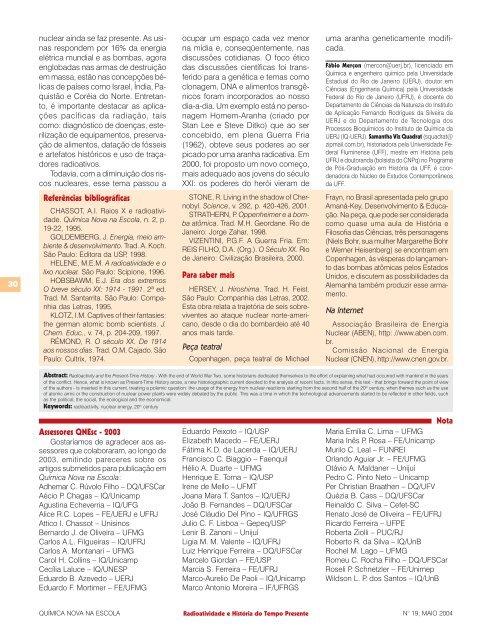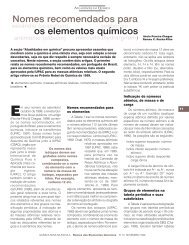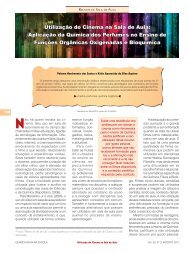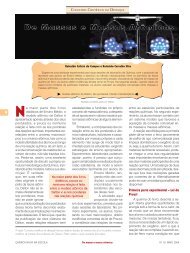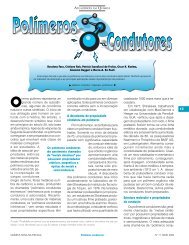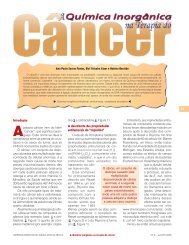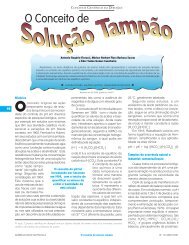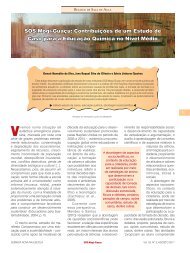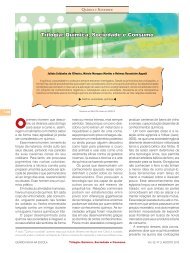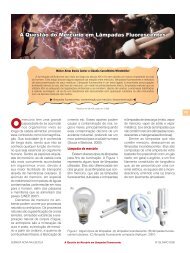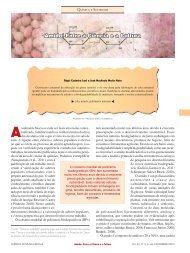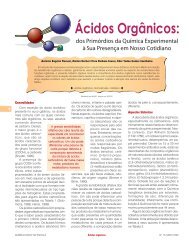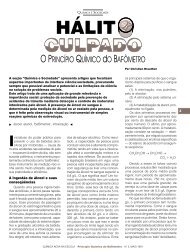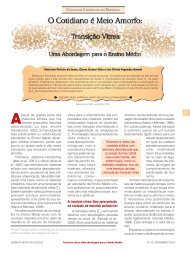A Radioatividade e a História do Tempo Presente - QNEsc
A Radioatividade e a História do Tempo Presente - QNEsc
A Radioatividade e a História do Tempo Presente - QNEsc
You also want an ePaper? Increase the reach of your titles
YUMPU automatically turns print PDFs into web optimized ePapers that Google loves.
30<br />
nuclear ainda se faz presente. As usinas<br />
respondem por 16% da energia<br />
elétrica mundial e as bombas, agora<br />
englobadas nas armas de destruição<br />
em massa, estão nas concepções bélicas<br />
de países como Israel, Índia, Paquistão<br />
e Coréia <strong>do</strong> Norte. Entretanto,<br />
é importante destacar as aplicações<br />
pacíficas da radiação, tais<br />
como: diagnóstico de <strong>do</strong>enças, esterilização<br />
de equipamentos, preservação<br />
de alimentos, datação de fósseis<br />
e artefatos históricos e uso de traça<strong>do</strong>res<br />
radioativos.<br />
Todavia, com a diminuição <strong>do</strong>s riscos<br />
nucleares, esse tema passou a<br />
Referências bibliográficas<br />
CHASSOT, A.I. Raios X e radioatividade.<br />
Química Nova na Escola, n. 2, p.<br />
19-22, 1995.<br />
GOLDEMBERG, J. Energia, meio ambiente<br />
& desenvolvimento. Trad. A. Koch.<br />
São Paulo: Editora da USP, 1998.<br />
HELENE, M.E.M. A radioatividade e o<br />
lixo nuclear. São Paulo: Scipione, 1996.<br />
HOBSBAWM, E.J. Era <strong>do</strong>s extremos<br />
O breve século XX: 1914 - 1991. 2ª ed.<br />
Trad. M. Santarrita. São Paulo: Companhia<br />
das Letras, 1995.<br />
KLOTZ, I.M. Captives of their fantasies:<br />
the german atomic bomb scientists. J.<br />
Chem. Educ., v. 74, p. 204-209, 1997.<br />
RÉMOND, R. O século XX. De 1914<br />
aos nossos dias. Trad. O.M. Caja<strong>do</strong>. São<br />
Paulo: Cultrix, 1974.<br />
ocupar um espaço cada vez menor<br />
na mídia e, conseqüentemente, nas<br />
discussões cotidianas. O foco ético<br />
das discussões científicas foi transferi<strong>do</strong><br />
para a genética e temas como<br />
clonagem, DNA e alimentos transgênicos<br />
foram incorpora<strong>do</strong>s ao nosso<br />
dia-a-dia. Um exemplo está no personagem<br />
Homem-Aranha (cria<strong>do</strong> por<br />
Stan Lee e Steve Ditko) que ao ser<br />
concebi<strong>do</strong>, em plena Guerra Fria<br />
(1962), obteve seus poderes ao ser<br />
pica<strong>do</strong> por uma aranha radioativa. Em<br />
2000, foi proposto um novo começo,<br />
mais adequa<strong>do</strong> aos jovens <strong>do</strong> século<br />
XXI: os poderes <strong>do</strong> herói vieram de<br />
STONE, R. Living in the sha<strong>do</strong>w of Chernobyl.<br />
Science, v. 292, p. 420-426, 2001.<br />
STRATHERN, P. Oppenheimer e a bomba<br />
atômica. Trad. M.H. Geordane. Rio de<br />
Janeiro: Jorge Zahar, 1998.<br />
VIZENTINI, P.G.F. A Guerra Fria. Em:<br />
REIS FILHO, D.A. (Org.). O Século XX. Rio<br />
de Janeiro: Civilização Brasileira, 2000.<br />
Para saber mais<br />
HERSEY, J. Hiroshima. Trad. H. Feist.<br />
São Paulo: Companhia das Letras, 2002.<br />
Esta obra relata a trajetória de seis sobreviventes<br />
ao ataque nuclear norte-americano,<br />
desde o dia <strong>do</strong> bombardeio até 40<br />
anos mais tarde.<br />
Peça teatral<br />
Copenhagen, peça teatral de Michael<br />
uma aranha geneticamente modificada.<br />
Fábio Merçon (mercon@uerj.br), licencia<strong>do</strong> em<br />
Química e engenheiro químico pela Universidade<br />
Estadual <strong>do</strong> Rio de Janeiro (UERJ), <strong>do</strong>utor em<br />
Ciências (Engenharia Química) pela Universidade<br />
Federal <strong>do</strong> Rio de Janeiro (UFRJ), é <strong>do</strong>cente <strong>do</strong><br />
Departamento de Ciências da Natureza <strong>do</strong> Instituto<br />
de Aplicação Fernan<strong>do</strong> Rodrigues da Silveira da<br />
UERJ e <strong>do</strong> Departamento de Tecnologia <strong>do</strong>s<br />
Processos Bioquímicos <strong>do</strong> Instituto de Química da<br />
UERJ (IQ-UERJ). Samantha Viz Quadrat (squadrat@<br />
zipmail.com.br), historia<strong>do</strong>ra pela Universidade Federal<br />
Fluminense (UFF), mestre em História pela<br />
UFRJ e <strong>do</strong>utoranda (bolsista <strong>do</strong> CNPq) no Programa<br />
de Pós-Graduação em História da UFF, é coordena<strong>do</strong>ra<br />
<strong>do</strong> Núcleo de Estu<strong>do</strong>s Contemporâneos<br />
da UFF.<br />
Frayn, no Brasil apresentada pelo grupo<br />
Amaná-Key, Desenvolvimento & Educação.<br />
Na peça, que pode ser considerada<br />
como quase uma aula de História e<br />
Filosofia das Ciências, três personagens<br />
(Niels Bohr, sua mulher Margarethe Bohr<br />
e Werner Heisenberg) se encontram em<br />
Copenhagen, às vésperas <strong>do</strong> lançamento<br />
das bombas atômicas pelos Esta<strong>do</strong>s<br />
Uni<strong>do</strong>s, e discutem as possibilidades da<br />
Alemanha também produzir esse armamento.<br />
Na Internet<br />
Associação Brasileira de Energia<br />
Nuclear (ABEN), http: //www.aben.com.<br />
br.<br />
Comissão Nacional de Energia<br />
Nuclear (CNEN), http://www.cnen.gov.br.<br />
Abstract: Radioactivity and the Present-Time History - With the end of World War Two, some historians dedicated themselves to the effort of explaining what had occurred with mankind in the years<br />
of the conflict. Hence, what is known as Present-Time History arose, a new historiographic current devoted to the analysis of recent facts. In this sense, this text - that brings forward the point of view<br />
of the authors - is inserted in this current, treating a polemic question: the usage of the energy from nuclear reactions starting from the second half of the 20 th century, when themes such us the use<br />
of atomic arms or the construction of nuclear power plants were widely debated by the public. This was a time in which the technological advancements started to be reflected in other fields, such<br />
as the political, the social, the ecological and the economical.<br />
Keywords: radioactivity, nuclear energy, 20 th century<br />
Assessores <strong>QNEsc</strong> - 2003<br />
Gostaríamos de agradecer aos assessores<br />
que colaboraram, ao longo de<br />
2003, emitin<strong>do</strong> pareceres sobre os<br />
artigos submeti<strong>do</strong>s para publicação em<br />
Química Nova na Escola:<br />
Adhemar C. Rúvolo Filho – DQ/UFSCar<br />
Aécio P. Chagas – IQ/Unicamp<br />
Agustina Echeverria – IQ/UFG<br />
Alice R.C. Lopes – FE/UERJ e UFRJ<br />
Attico I. Chassot – Unisinos<br />
Bernar<strong>do</strong> J. de Oliveira – UFMG<br />
Carlos A.L. Filgueiras – IQ/UFRJ<br />
Carlos A. Montanari – UFMG<br />
Carol H. Collins – IQ/Unicamp<br />
Cecília Laluce – IQ/UNESP<br />
Eduar<strong>do</strong> B. Azeve<strong>do</strong> – UERJ<br />
Eduar<strong>do</strong> F. Mortimer – FE/UFMG<br />
Eduar<strong>do</strong> Peixoto – IQ/USP<br />
Elizabeth Mace<strong>do</strong> – FE/UERJ<br />
Fátima K.D. de Lacerda – IQ/UERJ<br />
Francisco C. Biaggio – Faenquil<br />
Hélio A. Duarte – UFMG<br />
Henrique E. Toma – IQ/USP<br />
Irene de Mello – UFMT<br />
Joana Mara T. Santos – IQ/UERJ<br />
João B. Fernandes – DQ/UFSCar<br />
José Cláudio Del Pino – IQ/UFRGS<br />
Julio C. F. Lisboa – Gepeq/USP<br />
Lenir B. Zanoni – Unijuí<br />
Ligia M. M. Valente – IQ/UFRJ<br />
Luiz Henrique Ferreira – DQ/UFSCar<br />
Marcelo Giordan – FE/USP<br />
Marcia S. Ferreira – FE/UFRJ<br />
Marco-Aurelio De Paoli – IQ/Unicamp<br />
Marco Antonio Moreira – IF/UFRGS<br />
Nota<br />
Maria Emília C. Lima – UFMG<br />
Maria Inês P. Rosa – FE/Unicamp<br />
Murilo C. Leal – FUNREI<br />
Orlan<strong>do</strong> Aguiar Jr. – FE/UFMG<br />
Otávio A. Maldaner – Unijuí<br />
Pedro C. Pinto Neto – Unicamp<br />
Per Christian Braathen – DQ/UFV<br />
Quézia B. Cass – DQ/UFSCar<br />
Reinal<strong>do</strong> C. Silva – Cefet-SC<br />
Renato José de Oliveira – FE/UFRJ<br />
Ricar<strong>do</strong> Ferreira – UFPE<br />
Roberta Ziolli – PUC/RJ<br />
Roberto R. da Silva – IQ/UnB<br />
Rochel M. Lago – UFMG<br />
Romeu C. Rocha Filho – DQ/UFSCar<br />
Roseli P. Schnetzler – FE/Unimep<br />
Wildson L. P. <strong>do</strong>s Santos – IQ/UnB<br />
QUÍMICA NOVA NA ESCOLA <strong>Radioatividade</strong> e História <strong>do</strong> <strong>Tempo</strong> <strong>Presente</strong><br />
N° 19, MAIO 2004


